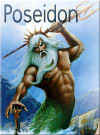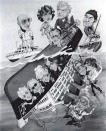|
JRR/CWR |
the Movie Club Annals ...

Beyond
the Poseidon Adventure
Reviewed by Tony W.
| Rating: 8 Poseidons | |||||||||
|
||
|
|
||
|
|
Beyond The Poseidon Adventure, Way Beyond Verisimilitude |
|
|
Do
not fear Perfection. You will never attain it. Salvador Dali |
||
|
Preface
|
||
| When I first learned of Carl R’s passion for bad film, I wondered why anyone would knowingly search out bad cinema instead of the good. Don’t we already know all of the bad films and, once known, shouldn’t they be avoided? The Ed Woods of filmdom, whose irredeemable efforts usually head the “Worst of…” lists, have become household names. Was Carl simply erecting virtual road signs to detour the undiscerning viewer away from Hollywood’s potholes and washouts? Or, like many critics, did his identification and documentation of failure shore up a delusional sense of superiority? What drew a smart and articulate fellow like Carl to this celluloid trash heap? | ||
| My own film interests consist largely of “guilty pleasures”, most notably the low-budget but spiritually provocative “B movies” of the 40s and 50s. For me, the unrealized potential behind these films manqué makes them successful. Great plots and evocative atmosphere redeem poor execution, inferior acting, and limited resources. | ||
| But Carl, I learned, was charting out a complementary territory, focusing on films which had little excuse for failure – films with big budgets, established actors, major studio distribution, and, consequently, high expectations. Under his guidance, I watched a few such bad films. While I laughed at the clichés, indifferent acting, and tired plots of his recommendations, it was sometimes difficult to endure their unrelenting longueurs, even with their frequent punctuation by hysterical melodrama. | ||
| Any moderately competent film encourages a suspension of disbelief on the part of the viewer. We forgive minor oversights in service of greater themes. The films suggested by Carl inspired no such leniency of spirit. Instead, I found that my impulse to rebuke was more keenly engaged both during and after viewing them. In a short time, I was mapping out multiple levels on which these films were failing. No binary “Success/Fail” measure could suffice to describe the inadequacies I was experiencing. Just as there are inner regions in Dante’s concentric vision of Hell, so too are there inner circles of cinematic failure . | ||
|
Beyond
The Poseidon Adventure |
||
| Beyond The Poseidon Adventure (BTPA) may well occupy the innermost circle of bad filmdom. As a parasitic sequel to a bad movie, it plumbs great depths of incompetence. At its core is a thin disaster plot adorned with uninspired dialogue, inconsistent characterization, and lapses in verisimilitude which corrupt nearly every scene. While its elaborate sets and mediocre effects represent an halfhearted gesture towards physical realism, the articulation of the plot divorces itself from credulity from the film’s outset. Formulaic cinema clichés, a characteristic of the Irwin Allen opus, take center stage over inspired creativity. No efforts were made to work out the details necessary to render the action minimally realistic or plausible. Instead, the film wallows along incompetently, oblivious to all except its apparent goal of reaching the final scene. | ||
| An action film, especially one of the “disaster” genre, relies on an atmosphere of imminent danger, compelling portrayals of fear, and careful, believable special effects to engage its audience. The intertwined fates of strangers and the occasion of ironic destiny offer great potential. Yet, all BTPA can muster are regular paroxysms of the capsized boat to nudge the plot along, two-dimensional acting, and monotony galore. It could serve as an object lesson on how to cleanse a film of dramatic tension. | ||
| What follows is a series of personal observations intended to circumscribe the expanse of this film’s badness. You should probably defer reading these comments until after you have watched BTPA. At that time, you’ll be able to expand the list tenfold. | ||
| Where to begin? Even documenting BTPA’s failings accords it undeserved respect. Like a poorly conceived and badly written essay, it invites a sequence of criticisms each entangled with its predecessor. Any attempt at theoretical analysis is an exercise in frustration akin to the anguish of viewing BTPA itself. Perhaps the scattered and unrelated questions and observations below best “tell it like it is.” Here goes, in no particular order. | ||
| 1. Why is Karl Malden singled out in the opening credits as “Wilbur”? And why is the name enclosed in quotation marks? Is this a star turn? | ||
|
2. Why did such accomplished professionals as Michael Caine, Sally Field, Shirley Knight, and Jack Warden lend their reputations to this vehicle? Think of Michael Caine’s contributions to film. Sally Field won an Oscar. Jack Warden is one of cinema’s great supporting actors. Shirley Knight starred in Tennessee William’s “Sweet Bird of Youth” with Paul Newman. |
||
|
3. What is Michael Caine’s small tugboat doing in the middle of the sea in a storm? Why, if this delivery voyage is so critical, was his cargo not more safely secured? |
||
|
4. The film allegedly takes place on New Year’s Day. Judging from the quality of daylight and the implied length of time Caine and company spend in the ship and the hour of day when they discover the wreck, we must conclude that the ship has just capsized. Yet no rescue ships or newsmen seem to be in the area. Are such events so typical as to not warrant attention by rescue organizations or the news media? |
||
|
5. Michael Caine’s greed for whatever wealth the Purser’s Room contains is, of course, the clichéd gesture of a good man, desperate to preserve his honest means of livelihood and “be his own man” in a world menaced by cold moneylenders. Why, then, is he so cavalier about securing the Purser’s riches to his person once he has found them? He merely hangs two small bags, joined by a flimsy string, across his shoulders, knowing from recent experience of the physical demands and risks that will be required to climb back up to the exit in the hull. |
||
|
6. And, speaking of that hull, what ship that has been in the ocean more than a week features a hull which gleams as if it had been Simonized in the last hour? Nary a barnacle to be seen. |
||
|
7. Telly Savalas, playing the condescendingly arrogant doctor/smuggler, seems to have planned carefully the acquisition and transportation of his plutonium booty. How, then, is he so inadequate to the task of removing Caine’s crew from possible interference? How is it that, of his entire remaining crew in the final scene, only one has a weapon? |
||
| 8. Why is the interior of a capsized ship so uniformly lighted, even underwater? | ||
|
9. When Caine’s group is forced to retreat to the room in which Telly Savalas’ team has located the plutonium, Telly must indulge in the requisite cliché of unnecessary explanation of his intentions rather than simply slaughtering his captives. |
||
|
10. Caine, Boyle, and Harmon pick up automatic weapons from the stash and demonstrate instant proficiency with using them. How did a country boy from Iowa acquire such a skill? |
||
|
11. What is Veronica Hamel’s relationship with Telly? Why did she abandon his more certain chance of escape in favor of Caine’s less promising and more helpless position? She is obviously a partner to Telly’s crime, but her character is eliminated so quickly that her mere introduction was useless. |
||
|
12. And, how did Hamel, a woman shot through the back with an automatic rifle, manage to lay in wait and then kill the henchman who shot her? |
||
|
13. Knowing what they did about Telly’s crew and knowing that they may well confront them again , how did the Caine group allow themselves to part with their only means of defense, their automatic weapons? |
||
|
14. In the first few moments of the film, we are shown three consecutive close-up views of Michael Caine steering the boat in the storm. Each has different lighting and granularity. With such a budget, couldn’t Allen have been able to afford another 3 seconds of quality stock? What is the purpose of these three scenes?. |
||
|
15. When Telly and company, on the ship’s hull, are retrieving their plutonium and weapons from the hold, they simply lower their nets directly down to the hold. Yet, they were unable to escape from the hold in so direct a fashion. |
||
|
16. Why, even though the ship is upside down, is an automobile hanging upside down from the “ceiling” (actually , floor) above? |
||
| 17. Wasn’t it convenient that SCUBA gear was located so close to the ultimate exit of the ship? | ||
|
18. Why does Shirley Jones resemble a drowned mouse throughout the film while Shirley Knight retains her regal elegance in the same surroundings? |
||
|
19. In the final scene, Telly instructs his only armed gunman to shoot and kill Slim Pickens, a complete non- threat, who is swimming toward Michael Caine’s tugboat. Shouldn’t Telly have reserved his only armed (and wounded ) henchman for the more important job of preventing the tug’s escape? |
||
|
20. How lucky that the Poseidon’s final explosion occurred just in time to destroy Telly and his gang, thereby saving Michael Caine, Sally Field, and their plucky companions! |
||
|
Ad Infinitum. |
||
|
Object Lesson |
||
| And what wisdoms can we glean from BTPA and its like? First to mind is the recommendation to steer clear of Irwin Allen, whose efforts (The Lost World, Voyage To The Bottom of The Sea, et al) all possess the stillborn and banal sameness of worn-out cliché. Second, before watching a sequel, ask yourself how much you enjoyed the original. What is the probability that a sequel will be worth watching, regardless of the quality of the original? Third, can you think of any “disaster” genre film whose viewing was itself not a disaster? | ||
| Perhaps the “poseidon” should be the unit of measure of bad film. But as bad as BTPA is, I feel that the Holy Grail of Bad Film is still out there. For this reason, I’ll rate BTPA as 8 poseidons out of a worst possible rating of 10. Somewhere an unsuspecting person may be notching into a VCR an unfamiliar, innocuously titled film and innocently settling back for an unexpected encounter with The Inexcusably Worst Film Ever Made. I’ve heard Carl talking about some possibilities. It’s good to know that he’s still on the case. | ||
|
The End |
||
|
Reviewed by Tony Weisgram with malice afterthought. |
||
|
|
||









